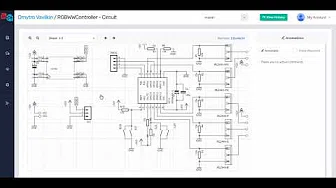Files
Scanning the repository...
| Filesinterface_modulefirmware | |
|---|---|
| .. | |
| data | |
| include | |
| lib | |
| src | |
| test | |
| .gitignore | |
| OTA_BUILD_GUIDE.md | |
| README.md | |
| REST_WebSocket_API.md | |
| SERIAL_COMMANDS.md | |
| build_ota.sh | |
| build_version.py | |
| copy_ota.sh | |
| copy_ota_files.py | |
| platformio.ini | |
| test_build.py |
README.mdESP32 6x2 Antenna Switch - Interface Module Firmware
Modern ESP32-based firmware for the 6x2 matrix antenna switch, providing comprehensive control through web interface, REST API, WebSocket, and serial commands with Over-The-Air (OTA) update capabilities.
Overview
This firmware transforms the antenna switch into a smart, network-connected device that can be controlled remotely through multiple interfaces:
- 🌐 Web Interface: Intuitive browser-based control panel
- 🔗 REST API: HTTP endpoints for integration with external systems
- ⚡ WebSocket: Real-time bidirectional communication
- 📟 Serial Commands: Direct UART control for automation
- 🔄 OTA Updates: Wireless firmware and filesystem updates
- 🏠 mDNS Discovery: Automatic network discovery (
antenna.local)
Features
Control Interfaces
- Web UI: Modern responsive interface at
http://antenna.local - REST API: 20+ endpoints for programmatic control
- WebSocket: Real-time state updates and control
- Serial: Simple text commands via USB or RS-485
Smart Features
- Antenna Swapping Prevention: Automatic conflict resolution
- Single Radio Mode: Lock to one radio for simplex operation
- Safety Interlocks: Relay disconnect during firmware updates
- Persistent Settings: Configuration survives power cycles
- Real-time Feedback: Instant status updates across all interfaces
Network & Updates
- WiFi Manager: Easy network configuration with fallback AP mode
- mDNS: Access via
antenna.localhostname - OTA Updates: Wireless firmware and web file updates
- Dual Upload: Maintains USB serial compatibility for development
Hardware Requirements
- ESP32 DevKit V1 (or compatible)
- 6x2 Antenna Switch Module (relay control board)
- 5V Power Supply (adequate for ESP32 + relays)
Pin Assignments
Radio 1 Relays: GPIO 18, 5, 17, 16, 4, 2 (Antennas 1-6)
Radio 2 Relays: GPIO 15, 13, 12, 14, 27, 26 (Antennas 1-6)
Status LED: GPIO 25
Quick Start
1. Build and Flash
# Clone and setup
git clone <repository>
cd interface_module/firmware
Build firmware
pio run -e esp32doit-devkit-v1
Upload via USB
pio run -e esp32doit-devkit-v1 -t upload
Upload web files
pio run -e esp32doit-devkit-v1 -t uploadfs
2. Initial Setup
- Connect to WiFi: Device creates
AntennaSwitch-XXXXAP for initial setup - Configure Network: Use WiFi Manager portal to connect to your network
- Access Interface: Navigate to
http://antenna.localor device IP
3. Basic Operation
- Web Control: Use browser interface for manual switching
- API Integration: Connect external software via REST API
- Serial Control: Send commands via USB serial at 115200 baud
Documentation
📚 Complete API References
- REST & WebSocket API - HTTP endpoints and real-time WebSocket communication
- Serial Commands - UART command interface for automation and integration
🔧 Build & Deployment
- OTA Build Guide - Firmware building, OTA updates, and deployment workflows
📋 Quick Reference Cards
Web Interface URLs
- Main Control:
http://antenna.local/ - Settings:
http://antenna.local/settings - System Status:
http://antenna.local/status - OTA Updates:
http://antenna.local/ota
Common API Endpoints
# Get current antenna state
curl http://antenna.local/api/state
Switch Radio 1 to Antenna 3
curl -X POST http://antenna.local/api/antennas \ -H "Content-Type: application/json" \ -d '{"1":3}'
Get system status
curl http://antenna.local/api/status
Serial Commands
set 1 3 # Switch Radio 1 to Antenna 3
get 1 # Get current antenna for Radio 1
? # Device information
test # Test all relays
Architecture
Core Components
main.cpp: Application entry point and main loopantenna_hardware.cpp: Relay control and switching logicweb_server.cpp: HTTP server and REST API endpointswebsocket.cpp: Real-time WebSocket communicationcommand_parser.cpp: Serial command processingwifi_manager.cpp: Network configuration and management
Web Assets (data/ directory)
index.html: Main control interfacesettings.html: Configuration pagestatus.html: System information displayota.html: Firmware update interfacestyle.css: Responsive UI stylingscript.js: Client-side JavaScript logic
Development
Build Environments
# USB Development (default)
[env:esp32doit-devkit-v1]
upload_port = /dev/ttyUSB0
Wireless OTA Updates
[env:esp32doit-devkit-v1-ota] uploadprotocol = espota uploadport = antenna.local
Dependencies
- ESPAsyncWebServer: HTTP server with async support
- WebSocketsServer: Real-time bidirectional communication
- ArduinoJson: JSON parsing and generation
- WiFiManager: Network configuration portal
- ArduinoOTA: Over-the-air update support
Build Scripts
build_ota.sh: Complete build with automatic file copyingcopy_ota_files.py: Manual file copying for OTA deploymentbuild_version.py: Automatic versioning and timestamp injection
Configuration
WiFi Setup
- Initial Setup: Device creates
AntennaSwitch-XXXXaccess point - Connect: Join AP and navigate to
192.168.4.1 - Configure: Select your WiFi network and enter credentials
- Automatic: Device connects to your network and starts mDNS
Default Settings
- Hostname:
antenna(accessible viaantenna.local) - OTA Password:
antenna123 - WebSocket Port:
81 - Serial Baud:
115200
Customization
- Antenna Names: Configure via web interface or API
- Operation Modes: Single radio mode, antenna swapping prevention
- Network Settings: Static IP, custom hostname via web settings
Troubleshooting
Common Issues
Device Not Accessible:
- Check WiFi connection and signal strength
- Try IP address instead of antenna.local
- Reset network settings via serial: AT+RST
OTA Update Fails: - Verify file type (firmware vs SPIFFS) - Check available flash space - Ensure stable WiFi connection during upload
Relays Not Switching:
- Check power supply capacity (relays need adequate current)
- Verify pin connections against hardware documentation
- Use test serial command to verify hardware operation
Debug Access
- Serial Monitor: Connect USB, open serial terminal at 115200 baud
- System Status: Check
/statuspage for detailed system information - API Status: Use
/api/statusendpoint for JSON system data








